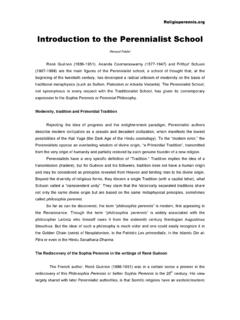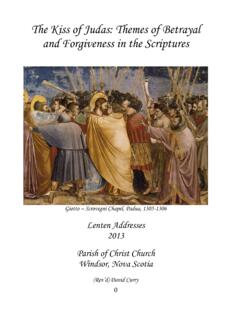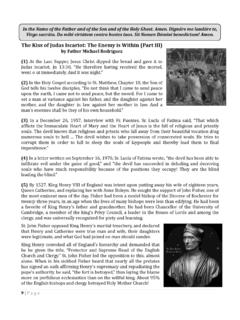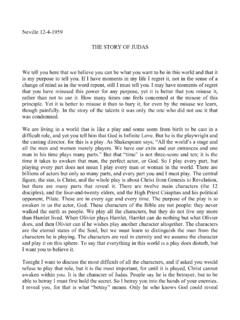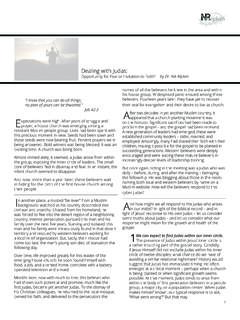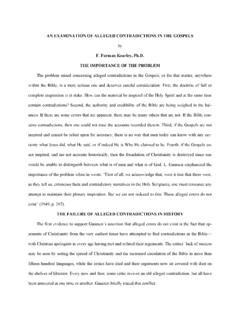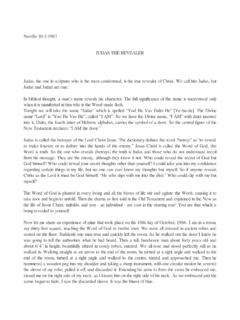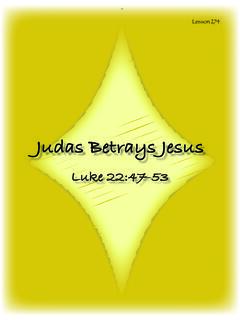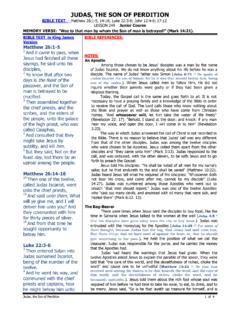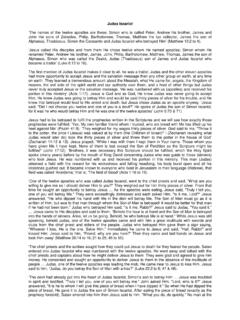Transcription of The Kiss of Judas - Frithjof Schuon
1 kiss of JudasReflections on Giotto di Bondone s kiss of Judas (Arena Chapel, 1304-06) and Duccio diBuoninsegna s The Betrayal of Christ (Maesta Altarpiece, 1308-11).Timothy ScottKiss of Judas (Giotto)The Betrayal of Christ (Duccio) was still speaking when a crowd arrived, led by Judas , one of the twelvedisciples. He came up to Jesus to kiss him. But Jesus said, Judas , is it with a kiss thatyou betray the Son of Man? When the disciples who were with Jesus saw what was goingto happen, they asked, Shall we use our swords, Lord? And one of them struck the HighPriest s slave and cut off his right ear. But Jesus said, Enough of this! He touched theman s ear and healed him. Then Jesus said to the chief priests and the officers of thetemple guard and the elders who had come there to get him, Did you have to come withswords and clubs, as though I were an outlaw? I was with you in the Temple every day,and you did not try to arrest me.
2 But this is your hour to act, when the power of darknessrules. (Luke 22:47-53)Duccio di Buoninsegna s The Betrayal of Christ (Maesta Altarpiece, 1308-11)presents an immediate wealth of religious symbolism. One s vision is instantaneouslyarrested by the brilliance of Christ s cloak. The startling blue of this garment speaksdirectly to our primordial imagination of the sky above infinite, this is the divine infinitude, the virginal plenitude from whence Christ isborn and which remains constant as the mysterious substratum of existence. Aroundthis blue burns the gold rimming at once both sunrise and sunset, simultaneouslysetting ablaze the horizon. This golden sun is both the phenomenal sun that speaksof the daily cycle and also the Divine Sun that remains always the Centre, itsrays none other than the Holy Spirit reaching out to pluck forth existence from theDivine Substance.
3 One must not, however, fall prey to thinking that this type of symbolic reading isno more than arbitrary association of sign and significance, as if true symbolism couldbe simply arbitrary. By way of an example of this point: Duccio uses ultra marine asthe colour of Christ s cloak; this pigment, reserved for the colour of the Virgin s cloak,is made from ground lapis lazuli, which, as Mircea Eliade has remarked, is the cosmicsymbol above all others (the starry night) ;1 this then recalls the Maris Stella, and in 1 Eliade, Patterns in Comparative Religion London: Sheed and Ward, 1983, , the association between the symbolism of the sea and the sky. This web ofsymbolic homologues works to reinforce the primarily efficaciousness of thechromatic nature of ultra marine, which absorbs light, and thus vision, creating a depththat the viewer disappears into like a drop into the ocean.
4 In the final analysis it is thechromatic effect of Duccio s colours that holds the key to their symbolism, which isfirstly and foremost, the intuitive feeling they evoke. To continue with the symbolism of Duccio s Betrayal of Christ. Beneath Christ smarvellous cloak his inner garment is the red of the Passion, the colour of the mortalblood that must flow to prove his humanity. Then there is the structure of Duccio sdepiction, complementarily spatial and temporal. Stark against the sky, three treesrise up to hold court over the proceeding events. These throw attention to severalother ternary groupings that rush us through the coming hours to the three crossesrising at Golgotha. These trees again flag the three-stage narrative of the whole these are the central betraying kiss , the anger of Peter as he slashes out atthe servant s ear to the right of Christ, and the fleeing disciples at Christ s left.
5 In comparison, and at first glance, Giotto di Bondone s kiss of Judas (ArenaChapel, 1304-06) might appear to lack the wealth of symbolism evident in Duccio spainting. The colours of Christ s garments again the blue and red are obscured,hidden under the enveloping embrace of Judas . Likewise the symbolic division intothree-fold space is lost in the dark mass of Giotto s arresting mob. Yet Giotto sdepiction asserts a profundity that resonates deep within the heart. Giotto s paintingspeaks directly, like the colours themselves. His kiss of Judas is less concerned withan intellectual, in the modern sense of the word, symbolism and far less with realism. Instead Giotto expresses the Real through the reality of Jesus Christ ashuman. At the centre of the scene Jesus gazes silently upon Judas face, while aroundand outside this silence rushes the tumultuous chaos of the mob.
6 In this gaze, thiseternal moment, Giotto s Christ is alive. Not life-like, as realism strives for, but alive:living, breathing, grieving, hurting. Christ is human, precisely what the expresses. In comparison Duccio s painting suddenly appears almostformulaic, although this is far too harsh a criticism to level against such a s living, human Jesus embodies the truth of God more immediate than anysignal-signified symbolism might ever achieve. This is not to deny the pre-eminenceof symbolism among the sacred sciences. In fact, if symbolism is properlyunderstood then Christ is the Christian symbol par excellence. While sacredsymbolism is the language of communication with God, Christ s life is the Wordimmediate and direct.*It is St. John who verbally paints the scene that Giotto embodies in plaster,water, and pigments: So Judas went to the garden, taking with him a group of Romansoldiers, and some temple guards sent by the chief priests and the Pharisee; they werearmed and carried lanterns and torches (John 18:3).
7 But it is St. Luke who gives asense of the pangs of human hurt that Jesus suffers at being betrayed by one of hisapostles: He drew near to Jesus to kiss him; but Jesus said to him, Judas , would youbetray the Son of Man with a kiss ? (Luke 22:47). Jesus does not let Judas actuallykiss him: but Jesus said to him . This denial tends towards a sense of Christ shumanity; it evokes Jesus pain at this betrayal. It could be suggested that this denialof the kiss is shown in Duccio s painting. Jesus right arm appears to be holdingJudas at bay. Yet the gesture of the hand is that of a blessing. This action may showChrist s healing of the servant s ear. Again, this blessing may express Christ sforgiveness of Judas . Indubitably this action is manifold in can be no doubt Christ forgave his betrayer for what in the end is a tragicnecessity. This sense of forgiveness is evident in both Duccio s and Giotto sdepictions.
8 But, whereas in Giotto the gaze of Jesus expresses both forgiveness andsorrow, in Duccio s Son of Man there appears to be little feeling for Judas and hisactions. Christ s immediate blessing and forgiveness appear almost compulsory, staring off instead to the imminent future. Maybe this shows the attitude of aman resigned to his fate. If this portrayal is seen in terms of Christ s human naturethen this resignation implies a will steeled and detached from the external events. Thisis to depict Christ as superhuman, which sets his example beyond the , seen in terms of Christ s divine nature, this resignation implies atranscendence of the oncoming events. This is to depict Christ as suprahuman, whichis to fall prey to the docetic heresy. In either case this resignation in the face of deathbelies Jesus human nature. If Duccio s Christ is suprahuman then he denies the veryhumanity of the Passion.
9 If he is human then his withdrawal robs him of thecompassion that is fundamental to the heart of Passion embodies two main themes: the humanity of Jesus Christ and theinfallible necessity of the Divine Will. This sense of God s Will is found prominent inSt. Matthew when Christ reprimands Peter for striking off the ear of the high priest sslave: all who live by the sword must die by the sword. Do you not think that Icannot appeal to my Father, and he will at once send me more than twelve legions ofangels? But how then should the scripture s be fulfilled, that it must be so? ( :51). Again, in St. John: Jesus said to Peter, Put your sword into its sheath; shallI not drink the cup which the Father has given me? (John 18:11). The mention of the cup recalls Christ s earlier pray to God: Father, ..my Father! All things arepossible for you. Take this cup of suffering away from me.
10 Yet not what I want, butwhat you want (Mark ). This episode is one of the most personal and humanlyrevealing moments in the life of Jesus. At the same time it is the most fundamentallesson on the nature of the Divine masters capture Peter s act of violence and so doing recall the abovescriptural teachings on Divine Will. Yet again it is Giotto who captures this action notonly as a symbol, but also as a living moment in time. To explain this further it isnecessary to understand the mechanics of time each painting s painting tells the gospel story of Christ s arrest though a progression oftime. Time follows a linear movement corresponding to the path of the eye as ourattention is directed from event to event. Central to the painting is the image ofChrist. Notably this is the only human figure whose attitude of body and stanceindicates a sense of stability. Christ then is the anchor, set out of time and aroundwhich time may flow.
